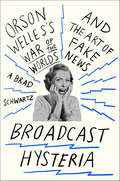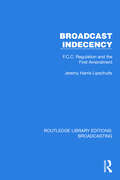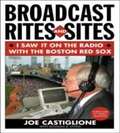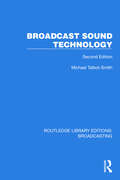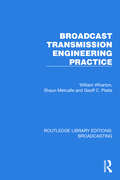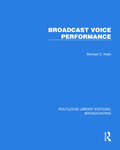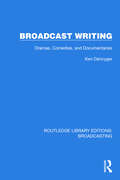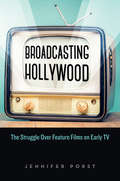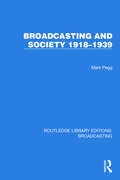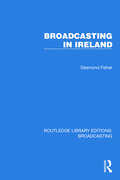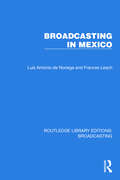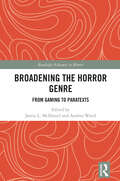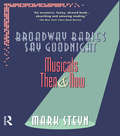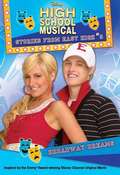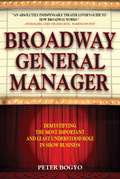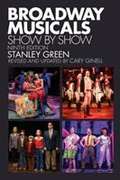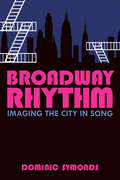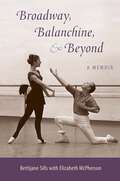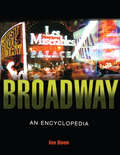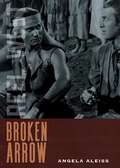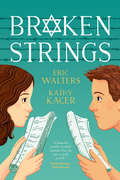- Table View
- List View
Broadcast Hysteria: Orson Welles's War of the Worlds and the Art of Fake News
by A. Brad SchwartzOn the evening of October 30, 1938, radio listeners across the United States heard a startling report of a meteor strike in the New Jersey countryside. With sirens blaring in the background, announcers in the field described mysterious creatures, terrifying war machines, and thick clouds of poison gas moving toward New York City. As the invading force approached Manhattan, some listeners sat transfixed, while others ran to alert neighbors or to call the police. Some even fled their homes. But the hair-raising broadcast was not a real news bulletin-it was Orson Welles's adaptation of the H. G. Wells classic The War of the Worlds. In Broadcast Hysteria, A. Brad Schwartz boldly retells the story of Welles's famed radio play and its impact. Did it really spawn a "wave of mass hysteria," as The New York Times reported? Schwartz is the first to examine the hundreds of letters sent to Orson Welles himself in the days after the broadcast, and his findings challenge the conventional wisdom. Few listeners believed an actual attack was under way. But even so, Schwartz shows that Welles's broadcast became a major scandal, prompting a different kind of mass panic as Americans debated the bewitching power of the radio and the country's vulnerability in a time of crisis. When the debate was over, American broadcasting had changed for good, but not for the better. As Schwartz tells this story, we observe how an atmosphere of natural disaster and impending war permitted broadcasters to create shared live national experiences for the first time. We follow Orson Welles's rise to fame and watch his manic energy and artistic genius at work in the play's hurried yet innovative production. And we trace the present-day popularity of "fake news" back to its source in Welles's show and its many imitators. Schwartz's original research, gifted storytelling, and thoughtful analysis make Broadcast Hysteria a groundbreaking new look at a crucial but little-understood episode in American history.
Broadcast Indecency: F.C.C. Regulation and the First Amendment (Routledge Library Editions: Broadcasting #7)
by Jeremy H. LipschultzBroadcast Indecency (1997) treats broadcast indecency as more than a simple regulatory problem in American law. The author’s approach cuts across legal, social and economic concerns, taking the view that media law and regulation cannot be seen within a vacuum that ignores cultural realities. It treats broadcast as a phenomenon challenging the policy approach of government regulation, and is an exploration of the political and social processes involved in the government control of mass media content.
Broadcast Rites and Sites: I Saw it on the Radio with the Boston Red Sox
by Joe Castiglione Douglas LyonsVeteran broadcaster Joe Castiglione has seen his share of heartbreaking games, especially from his vantage point at Fenway Park where he has called the Red Sox games for the last 20 years. In his newest book, Castiglione not only recounts the drama from the booth in Boston, but also his travels and baseball adventures throughout the country in his previous stints with the Cleveland Indians and Milwaukee Brewers over his 30-year career.
Broadcast Sound Technology (Routledge Library Editions: Broadcasting #8)
by Michael Talbot-SmithBroadcast Sound Technology (1995) covers the basic principles of all the main aspects of the broadcast chain, including microphones and loudspeakers technology, mixing consoles, recording and replay (analogue and digital) and the principles of stereo.
Broadcast Transmission Engineering Practice (Routledge Library Editions: Broadcasting #9)
by William Wharton Shaun Metcalfe Geoff C. PlattsBroadcast Transmission Engineering Practice (1992) contains a wealth of technical knowledge and practical experience, as well as detailed guidance on how to initiate, supervise and bring transmission engineering projects to fruition.
Broadcast Voice Performance (Routledge Library Editions: Broadcasting #10)
by Michael C. KeithBroadcast Voice Performance (1989) incorporates the insights and experience of more than 100 successful practising voice performers to succinctly and realistically examine the techniques, equipment and criteria of announcing within the context of major types of radio and television productions and programming formats.
Broadcast Writing: Dramas, Comedies, and Documentaries (Routledge Library Editions: Broadcasting #11)
by Ken DancygerBroadcast Writing (1991) looks at the tools necessary for writers to find and develop stories for radio and television. Through the use of numerous original examples, the reader learns to shape ideas into well-developed scripts. It addresses the challenges of documentary and dramatic writing for TV and radio, and provides examples for most of the different writing genres.
Broadcasting Hollywood: The Struggle Over Feature Films on Early TV
by Jennifer PorstBroadcasting Hollywood: The Struggle Over Feature Films on Early Television uses extensive archival research into the files of studios, networks, advertising agencies, unions and guilds, theatre associations, the FCC, and key legal cases to analyze the tensions and synergies between the film and television industries in the early years of television. This analysis of the case study of the struggle over Hollywood’s feature films appearing on television in the 1940s and 1950s illustrates that the notion of an industry misunderstands the complex array of stakeholders who work in and profit from a media sector, and models a variegated examination of the history of media industries. Ultimately, it draws a parallel to the contemporary period and the introduction of digital media to highlight the fact that history repeats itself and can therefore play a key role in helping media industry scholars and practitioners to understand and navigate contemporary industrial phenomena.
Broadcasting and Society 1918–1939 (Routledge Library Editions: Broadcasting #12)
by Mark PeggBroadcasting and Society (1983) examines the power of radio broadcasting as a medium of instant communication and entertainment. It is a detailed and critical examination of the social changes brought about by radio broadcasting in the crucial and formative stages between 1918 and 1939 – whether broadcasting was successful in keeping people better informed, in introducing wider interests, and its influence on social behaviour.
Broadcasting in Canada (Routledge Library Editions: Broadcasting #13)
by E.S. Hallman H. HindleyBroadcasting in Canada (1977) examines the unique challenges to broadcasting in the country: the size of the country, its small, dispersed population, and two official languages make radio and television coverage a difficult and costly enterprise. These conditions and pressures have led Canadians to construct a broadcasting system in which both public and private initiative have roles to play in bringing radio and television services to the community.
Broadcasting in Ireland (Routledge Library Editions: Broadcasting #14)
by Desmond FisherBroadcasting in Ireland (1978) outlines the historical and sociological background of Ireland to place the progress of its broadcasting service in the context of its post-independence development. It analyses the difficulties of running public service broadcasting financed by both licence fee and advertising, and competing in half its television reception area with two of the premier broadcasting systems in the world. With regular broadcasting beginning with Independence, its development was inevitably bound up with the process of building the political, economic and social framework of the new State, and this book closely examines how the Irish broadcasting system coped with the attending economic, cultural and political difficulties.
Broadcasting in Mexico (Routledge Library Editions: Broadcasting #15)
by Luis Antonio de Noriega Frances LeachBroadcasting in Mexico (1979) traces the birth and growth of Mexico’s broadcasting services against the background of its geographical, cultural, demographic, economic and political structure. The development of Mexican radio and television has been characterised by innovation and experiment by both government and private enterprise, and sometimes the country has been the beneficiary of these efforts and sometimes the victim. Up to a certain point, the cultural infrastructure of the country itself dictated the path taken by the media, although there have been temptations to imitate the established structure of other countries.
Broadcasting in the Netherlands (Routledge Library Editions: Broadcasting #16)
by Kees van der Haak Joanna SpicerBroadcasting in the Netherlands (1977) analyses Dutch broadcasting, describing the historical traditions of Dutch society, the ways in which radio and TV were set up, and shows how changes in Dutch politics, culture and economy – as well as technological innovation and liberalisation – have posed a set of challenges for the country.
Broadening the Horror Genre: From Gaming to Paratexts (Routledge Advances in Horror)
by Andrea Wood Jamie L. McDanielThis collection assembles a wide range of scholarship addressing the intersections, influences, and impacts of the horror genre’s proliferation across multiple forms of media.Covering film, television, websites, video games, tabletop and role-playing games, and social media, the volume highlights works from marginalized voices or from less scrutinized media. Building off one of Horror Studies’ traditional homes in film, the volume first features approaches to previously ignored innovations and offshoots related to cinematic and televisual horror, before moving to discuss how horror film conventions inform horror video and tabletop games and how games have started to influence film. Finally, the collection departs the world of film to examine online and non-academic multimodal/cultural discourses about horror, from popular movie reviewers to interactive online marketing and film promotions.This volume will interest scholars and students not only of Horror Studies and genre but also of film, media and television studies, digital media and video games, and transmedia studies.
Broadway Babies Say Goodnight: Musicals Then and Now
by Mark SteynThe glorious tradition of the Broadway musical from Irving Berlin to Jerome Kern and Rodgers and Hammerstein to Stephen Sondheim. And then . . . Cats and Les Miz. Mark Steyn's Broadway Babies Say Goodnight is a sharp-eyed view of the whole span of Broadway musical history, seven decades of brilliant achievements the best of which are among the finest works American artists have made. Show Boat, Oklahoma!, Carousel, Gypsy, and more. In an energetic blend of musical history, analysis, and backstage chat, Mark Steyn shows us the genius behind the 'simple' musical, and asks hard questions about the British invasion of Broadway and the future of the form. In this delicious book he gives us geniuses and monsters, hits and atomic bombs, and the wonderful stories that prove show business is a business which -- as the song goes --there's no business like.
Broadway Bird
by Alex TimbersA charming and heartfelt picture book about a little bird who dreams of making it big on Broadway, from Tony Award-winning Broadway director Alex Timbers.What Louisa loved most about living in Times Square wasn't the buzzzz of the city...No, it was that she could sing as loud as she wanted. She could sing all day and she could sing all night. Louisa was truly a Broadway bird.Louisa is a tiny parakeet with a HUGE dream: to be a Broadway star. But no matter what she does, everyone keeps telling her she's too small to make it big! When a chance at her big break comes, Louisa learns that no matter how small you are, with a little talent and a lot of hard work, you can do anything - even be on Broadway!With colorful, charming illustrations by artist Alisa Coburn, this heartfelt picture book from renowned Broadway director Alex Timbers is about persistence, believing in yourself, and, of course, the magic of Broadway.
Broadway Dreams (High School Musical Stories From East High #5)
by N. B. GraceBIG APPLE, HERE WE COME!! Troy, Gabriella, Chad, Taylor, Sharpay, and Ryan are headed to New York City on a class trip! Everyone is eager to bask in the lights of Times Square and explore the bustling streets of Manhattan. Then some unexpected opportunities arise: Sharpay and Ryan put on their dancing shoes and try out for a real Broadway musical, and Gabriella and Taylor vie for scholarship money on a game show. But are any of them ready for the level of competition they'll face? Bookshare has the other books in this series. Look for: #1 BATTLE OF THE BANDS, #2 WILDCAT SPIRIT, #3 POETRY IN MOTION, #4 CRUNCH TIME, #6 Heart to Heart, #7 Friends 4Ever, #8 GET YOUR VOTE ON, #9 Ringin' It In, #10 Turn Up The Heat. And #11 In The Spotlight.
Broadway General Manager: Demystifying the Most Important and Least Understood Role in Show Business
by Peter Bogyo“An absolutely indispensable theater lover’s guide to how Broadway works.” —Peter Marks, chief theater critic, Washington Post“Highly recommended for those considering theater as a career and for those who love theater and want to know more about what goes on before the curtain goes up and after.” —Library JournalBroadway General Manager is a fascinating, insightful, and entertaining glimpse into the normally closed world of theatrical general management. Penned by veteran Broadway insider Peter Bogyo, readers will gain an appreciation and understanding of what the business half of show business is all about. For the first time ever, gain backstage access to the fast-paced and glamorous world of Broadway. Broadway General Manager is an invaluable resource that examines actual production and operating budgets for a Broadway show and shares contracts for award-winning actors, directors, and designers, all of which are analyzed extensively. Also included are in-depth discussions on such topics as:How to get started as a general manager Negotiating contracts How the producing entity functions Programming the box office The issues related to hiring employees Binding insurance Financial overview Maintaining the run of a show What to do when sales start to slump Closing a show And much more Laced with humorous insights and personal anecdotes, Broadway General Manager will delight both the average theater lover as well as individuals with a serious interest in commercial arts management.
Broadway Musicals, Show By Show
by Stanley Green Cary GinellThis updated edition of one of the bestselling and comprehensive Broadway reference books, first published in 1985, has been expanded to include many of the most important and memorable productions of American musical theater, including revivals. Arranged chronologically, beginning with musicals from just after the Civil War, each successive edition of the book has added valuable updates about trends in musical theater as well as capsule features on the most significant musicals of the day. The ninth edition documents important musicals produced since the end of the 2012-2013 season through spring 2019. Broadway Musicals, Show by Show features a wealth of statistics and inside information, plus critical reception, cast lists, pithy commentary about each show, and numerous detailed indexes that no Broadway fan will want to be without. Since its original publication, Broadway Musicals has proved to be an indispensable addition to any Broadway aficionado's library.
Broadway Rhythm: Imaging the City in Song
by Dominic SymondsBroadway Rhythm is a guide to Manhattan like nothing you've ever read. Author Dominic Symonds calls it a performance cartography, and argues that the city of New York maps its iconicity in the music of the Broadway songbook. A series of walking tours takes the reader through the landscape of Manhattan, clambering over rooftops, riding the subway, and flying over skyscrapers. Symonds argues that Broadway's songs can themselves be used as maps to better understand the city though identifiable patterns in the visual graphics of the score, the auditory experience of the music, and the embodied articulation of performance, recognizing in all of these patterns, corollaries inscribed in the terrain, geography, and architecture of the city. Through musicological analyses of works by Gershwin, Bernstein, Copland, Sondheim and others, the author proposes that performance cartography is a versatile methodology for urban theory, and establishes a methodological approach that uses the idea of the map in three ways: as an impetus, a metaphor, and a tool for exploring the city.
Broadway, Balanchine, and Beyond: A Memoir
by Bettijane SillsIn this memoir of a roller-coaster career on the New York stage, former actor and dancer Bettijane Sills offers a highly personal look at the art and practice of George Balanchine, one of ballet’s greatest choreographers, and the inner workings of his world-renowned company during its golden years. Sills recounts her years as a child actor in television and on Broadway, a career choice largely driven by her mother, and describes her transition into pursuing her true passion: dance. She was a student in Balanchine’s School of American Ballet throughout her childhood and teen years, until her dream was achieved. She was invited to join New York City Ballet in 1961 as a member of the corps de ballet and worked her way up to the level of soloist. Winningly honest and intimate, Sills lets readers peek behind the curtains to see a world that most people have never experienced firsthand. She tells stories of taking classes with Balanchine, dancing in the original casts of some of his most iconic productions, working with a number of the company’s most famous dancers, and participating in the company’s first Soviet Union tour during the Cold War and Cuban Missile Crisis. She walks us through her years in New York City Ballet first as a member of the corps de ballet, then a soloist dancing some principal roles, finally as one of the “older” dancers teaching her roles to newcomers while being encouraged to retire. She reveals the unglamorous parts of tour life, jealousy among company members, and Balanchine’s complex relationships with women. She talks about Balanchine’s insistence on thinness in his dancers and her own struggles with dieting. Her fluctuations in weight influenced her roles and Balanchine’s support for her—a cycle that contributed to the end of her dancing career. Now a professor of dance who has educated hundreds of students on Balanchine’s style and legacy, Sills reflects on the highs and lows of a career indelibly influenced by fear of failure and fear of success—by the bright lights of theater and the man who shaped American ballet.
Broadway: An Encyclopedia
by Ken BloomThis volume is another example in the Routledge tradition of producing high-quality reference works on theater, music, and the arts. An A to Z encyclopedia of Broadway, this volume includes tons of information, including producers, writer, composers, lyricists, set designers, theaters, performers, and landmarks in its sweep.
Broken Arrow (Reel West Series)
by Angela AleissAn insightful history and analysis of the importance Delmer Daves' film Broken Arrow has in the western film genre. It was, for its time, a breakthrough in how Native Americans were depicted in the movies. The release of Broken Arrow in 1950 represented a turning point in Hollywood&’s portrayal of Native Americans. Film scholars have often cited director Delmer Daves&’s movie as the first sound film to depict the Native American sympathetically, and it appealed to a postwar ideal of tolerance and racial equality that became prominent in later Westerns. Yet Broken Arrow certainly has its flaws: the Apache speak English, whites are cast in leading Apache roles, and Apache culture is highly romanticized. Additionally, many scholars agree that the movie lacks the polish of Daves&’s later Western 3:10 to Yuma (1957), with its evocative cinematography and psychological undertones.Despite its inaccuracies and the many artistic liberties it takes, the movie contains powerful political and social statements about Hollywood and its attitude toward Indian/white relations. Author Angela Aleiss breaks down the way Broken Arrow probed these attitudes and influenced a long series of films with Native heroes that followed, marking a transformation in Hollywood&’s portrayal of Native Americans.
Broken Mirrors/Broken Minds: The Dark Dreams of Dario Argento
by Maitland McDonaghItalian filmmaker Dario Argento’s horror films have been described as a blend of Alfred Hitchcock and George Romero—psychologically rich, colorful, and at times garish, excelling at taking the best elements of the splatter and exploitation genres and laying them over a dark undercurrent of human emotions and psyches. Broken Mirrors/Broken Minds, which dissects such Argento cult films as Two Evil Eyes, The Bird with the Crystal Plumage, Suspiria, and Deep Red, includes a new introduction discussing Argento’s most recent films, from The Stendahl Syndrome to Mother of Tears; an updated filmography; and an interview with Argento.
Broken Strings
by Eric Walters Kathy KacerA violin and a middle-school musical unleash a dark family secret in this moving story by an award-winning author duo. For fans of The Devil's Arithmetic and Hana's Suitcase.It's 2002. In the aftermath of the twin towers -- and the death of her beloved grandmother -- Shirli Berman is intent on moving forward. The best singer in her junior high, she auditions for the lead role in Fiddler on the Roof, but is crushed to learn that she's been given the part of the old Jewish mother in the musical rather than the coveted part of the sister. But there is an upside: her "husband" is none other than Ben Morgan, the cutest and most popular boy in the school. Deciding to throw herself into the role, she rummages in her grandfather's attic for some props. There, she discovers an old violin in the corner -- strange, since her Zayde has never seemed to like music, never even going to any of her recitals. Showing it to her grandfather unleashes an anger in him she has never seen before, and while she is frightened of what it might mean, Shirli keeps trying to connect with her Zayde and discover the awful reason behind his anger. A long-kept family secret spills out, and Shirli learns the true power of music, both terrible and wonderful.
